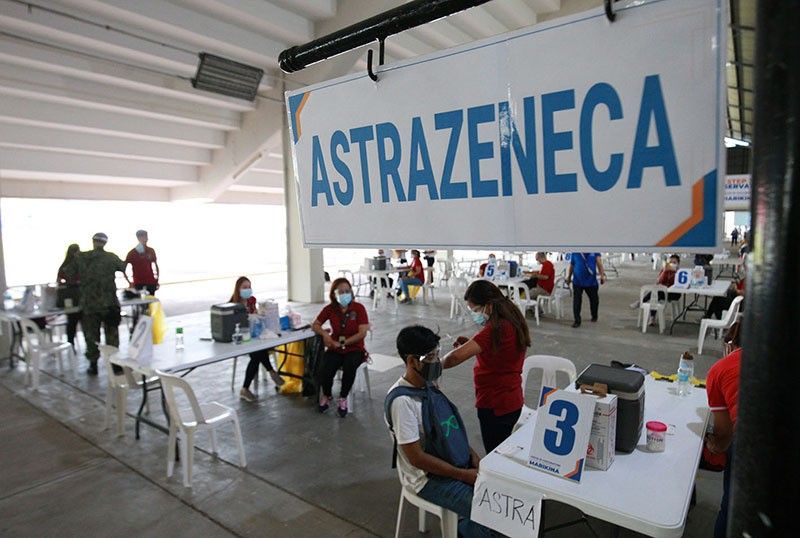Mass vaccinations are seen to start by May. Here's how to get the jab done

MANILA, Philippines — Vaccinations for the general public could begin by May, if government's timeline of the jabs' delivery are met. But what exactly are the steps in receiving it?
Inoculation efforts by end of March are still focused on health workers, with them being on top of the priority list. The Department of Health has reported too that over 700,000 had been vaccinated to date.
Several cities, particularly in Metro Manila, have already put up websites for residents to register to be vaccinated. This is because a master list is required, through the Vaccine Information Management System platform.
The vaccination process
A February 23 memorandum by the DOH outlines the seven steps on how the jabs will reach Filipinos' arms: pre-screening, scheduling, registration, screening, health education, administration, and follow-up.
While it seems like a long process, these are crucial for safety.
Vaccine recipients from special populations such as senior citizens with special conditions (ex., bedridden, in vegetative state, or limited life expectancy) and those immunocompromised should have medical clearance from their doctor. The agency said this is to discuss vaccine-specific risks, as well as the benefits "to the unique situation of the patient."
Scheduling will be handled by local government units. DOH said individuals willl be given a specific date and time as well as the location of the vaccination site prior to the actual vaccination.
They will also be given a "unique identifier" for a smooth flow and prevent congestion in sites.
Walk-ins are not allowed. But those on LGUs' quick substitution list should be informed of their possible schedules in case those to be vaccinated fail to show up.
This was how actor Mark Anthony Fernandez was vaccinated despite not being a medical worker, to the dismay of many. Parañaque Mayor Edwin Olivarez said he was on the list as he had conditions such as hypertension and depression.
RELATED: DOH: COVID-19 vaccination 'substitution list' must include health workers
Registration: Recipients will be registered in masterlists with some pieces of information such as their full name, birthday, PhilHealth ID number or QR codes. Further, they would need to present government-issued ID such as PRC or driver's license, UMID, PhilHealth or passport.
"In case of no government ID with picture, patients may present any government documents such as cedula, barangay certificate or birth certificate," the DOH memo continued.
Before persons are vaccinated, they will be checked for symptoms of the COVID-19 as well as possible comorbidities. DOH said inoculation of persons in some instances could be deferred until their situation is resolved. These are:
- If with symptoms for the virus, they will be vaccinated after a fully recovery.
- If exposed to confirmed or suspect patient in last two weeks, after a 14-day quarantine
- If a pregnant frontline health worker in their first trimester, only after the said trimester
- If a COVID-19 patient, after 90 days from the last day of their isolation or treatment. This is regardless of the whether their disease was mild, severe or critical.
- If a recipient of convalescent plasma or antibodies, also after 90 days from the last day of their treatment.
In the health education stage, recipients would be given information materials to get a better understanding of the vaccines. Here, questions and clarifications are encouraged, including on post-vaccination care.
Recipients also need to sign two copies of the informed consent form, which will be made available online.
So what's in it?
It would contain statements that the person understands that the vaccine is still an "investigational drug," as it was approved for emergency use, that they were assessed, and that all data collected in the vaccination program will be used for public health purposes.
When it finally reaches your arm
The sixth step is vaccine administration — you made it.
Recipient will be asked to wait in a designated area, where a safety officer should ensure that physical distancing measures are followed. They will then be led to the vaccination area, where a personnel will check if the jab is not expired and was stored at the right temperature.
Crucial: only licensed doctors or nurses may be vaccinators for vaccines that had Emergency Use Authorization. DOH said pharmacists may administer the jabs, but should undergo training from PRC-accredited institutions. Midwives could also assist in the effort.
"To prevent contamination of the vial, cleanliness and absence of potentially contaminated equipment shall be ensured at all times," DOH added.
Post-vaccination
Once done, the recipient's QR code will be scanned and inoculation details will be recorded in the Post Vaccination System. A vaccination card that will be made available physically and electronically will also be issued.
Those who receive the jab will also have to stay for 15 minutes for post-vaccination monitoring. Should life-threatening adverse events follow or severe allergic reactions, health workers "must be able to provide emergency treatment and resuscitative measures, such as the administration of life-saving medicines and basic life support."
DOH said the monitoring of adverse events following immunization will be for a year. LGUs are told to ensure that primary care providers are available to those who received the vaccine.
LGUs will also be responsible to notify recipients of the schedule their second dose, follow up and other relevant announcements.
What happens next?
While the vaccines are a significant welcome development, officials have repeatedly stressed that this alone would not put an end to the pandemic.
Those vaccinated should still follow the health protocols set, such as the wearing of face masks and face shields, as well as keeping their distance.
In one meeting of the coronavirus task force, vaccine czar Carlito Galvez Jr. presented a timetable of when the jabs are expected to arrive.
Still, as April approaches, government has so far signed a single purchase deal with a manufacturer — that is, for China's Sinovac at a million doses, which arrived on March 29.
While some administration officials have said in public that the Philippines has secured millions of doses with drugmakers through supply agreements, these are not final until the procurement is inked. 'Till then, the road to vaccinating 50 to 70 million Filipinos in 2021 remains a long way to go.
- Latest
- Trending






























